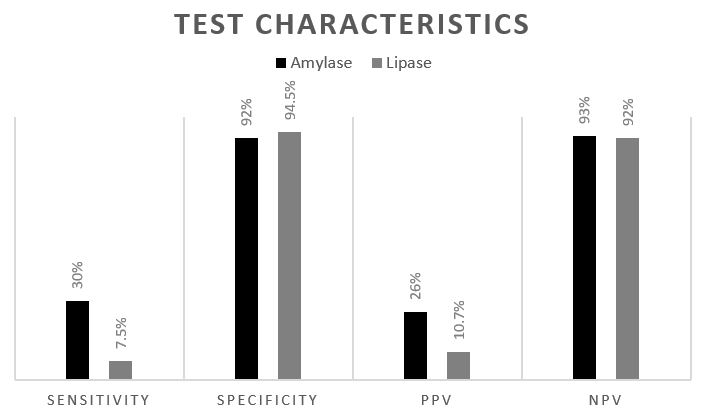Emergency Medicine: All Areas
Category: Abstract Submission
Emergency Medicine IX
371 - Evaluating the Utility of Serum Amylase Testing in Children with Abdominal Pain in the Pediatric Emergency Department
Sunday, April 24, 2022
3:30 PM - 6:00 PM US MT
Poster Number: 371
Publication Number: 371.312
Publication Number: 371.312
Rachel N. Friend, University of Central Florida College of Medicine, Rockledge, FL, United States; Andrea Rivera-Sepulveda, Nemours Children's Hospital, Orlando, FL, United States; David H. Hash, Nemours Children's Hospital, Saint Cloud, FL, United States

Rachel N. Friend, BS
Medical Student
University of Central Florida College of Medicine
Rockledge, Florida, United States
Presenting Author(s)
Background: Abdominal pathology is among the most common chief complaints seen in pediatric emergency departments (PED). During the routine laboratory evaluation of this affliction, pancreatic enzymes are frequently ordered. Clinical practice has historically demonstrated the dual use of serum amylase and lipase. However, there is limited literature on the effectiveness and diagnostic efficacy of both pancreatic enzymes when used to evaluate children for intra-abdominal pathology in the PED.
Objective: Evaluate the utility of independent versus concurrent serum amylase and lipase testing in the evaluation of intra-abdominal pathology in the PED.
Design/Methods: A retrospective, cross-sectional study was conducted on patients aged 0-18 years who received serum amylase and/or lipase testing while in the PED during from January 1st, 2019 to December 31st, 2019. Serum amylase or lipase were defined as abnormal when the levels were above or below the normal range. A clinically significant diagnosis was defined as a disease of the gallbladder, liver, pancreas, or duodenum. Diagnostic utility of serum amylase and lipase testing was determined through sensitivity, specificity, positive predictive value (PPV), negative predictive value (NPV), and likelihood ratio (LR). Chi-square or fisher’s exact test were used when appropriate.
Results: We identified 496 PED visits with tests for serum amylase (0.2%), lipase (53%), or both (46.8%). Median age was 11.5 years (interquartile range [IQR] 8.1-15.2 years). The most common chief complaints were abdominal pain (69%), vomiting (29%), nausea (1.8%) and abdominal distension (0.2%). Abnormal serum levels for amylase and lipase were 4.6% and 5.6%, respectively. The use of serum amylase in intra-abdominal pathology showed sensitivity 30%, specificity 92%, PPV 26%, NPV 93%, and LR 7.1 (p=0.008). The use of serum lipase in intra-abdominal pathology showed sensitivity 7.5%, specificity 94.5%, PPV 10.7%, NPV 92%, and LR 0.251 (p=0.616). The recalibration of serum amylase to three-times their normal levels showed sensitivity 10%, specificity 99.5%, PPV 66.7%, NPV 92.2%, LR 6.35 (p= 0.012); while lipase showed a sensitivity of 5%, specificity 99.3%, PPV 40%, NPV 92.2%, LR 3.9 (p=0.048). Identification of a clinically significant diagnosis via co-ordering of amylase and lipase versus lipase alone was not significant.Conclusion(s): While serum amylase and lipase testing may be suitable for abdominal pathology screening, the concurrent use of both does not seem to add any clinically significant value to diagnosis.
Curriculum Vitae - Rachel FriendFriend CV.pdf
Test Characteristics The sensitivity, specificity, positive predictive value (PPV), and negative predictive value (NPV) of amylase and lipase when a clinically-standardized normal range is used
The sensitivity, specificity, positive predictive value (PPV), and negative predictive value (NPV) of amylase and lipase when a clinically-standardized normal range is used
Objective: Evaluate the utility of independent versus concurrent serum amylase and lipase testing in the evaluation of intra-abdominal pathology in the PED.
Design/Methods: A retrospective, cross-sectional study was conducted on patients aged 0-18 years who received serum amylase and/or lipase testing while in the PED during from January 1st, 2019 to December 31st, 2019. Serum amylase or lipase were defined as abnormal when the levels were above or below the normal range. A clinically significant diagnosis was defined as a disease of the gallbladder, liver, pancreas, or duodenum. Diagnostic utility of serum amylase and lipase testing was determined through sensitivity, specificity, positive predictive value (PPV), negative predictive value (NPV), and likelihood ratio (LR). Chi-square or fisher’s exact test were used when appropriate.
Results: We identified 496 PED visits with tests for serum amylase (0.2%), lipase (53%), or both (46.8%). Median age was 11.5 years (interquartile range [IQR] 8.1-15.2 years). The most common chief complaints were abdominal pain (69%), vomiting (29%), nausea (1.8%) and abdominal distension (0.2%). Abnormal serum levels for amylase and lipase were 4.6% and 5.6%, respectively. The use of serum amylase in intra-abdominal pathology showed sensitivity 30%, specificity 92%, PPV 26%, NPV 93%, and LR 7.1 (p=0.008). The use of serum lipase in intra-abdominal pathology showed sensitivity 7.5%, specificity 94.5%, PPV 10.7%, NPV 92%, and LR 0.251 (p=0.616). The recalibration of serum amylase to three-times their normal levels showed sensitivity 10%, specificity 99.5%, PPV 66.7%, NPV 92.2%, LR 6.35 (p= 0.012); while lipase showed a sensitivity of 5%, specificity 99.3%, PPV 40%, NPV 92.2%, LR 3.9 (p=0.048). Identification of a clinically significant diagnosis via co-ordering of amylase and lipase versus lipase alone was not significant.Conclusion(s): While serum amylase and lipase testing may be suitable for abdominal pathology screening, the concurrent use of both does not seem to add any clinically significant value to diagnosis.
Curriculum Vitae - Rachel FriendFriend CV.pdf
Test Characteristics
 The sensitivity, specificity, positive predictive value (PPV), and negative predictive value (NPV) of amylase and lipase when a clinically-standardized normal range is used
The sensitivity, specificity, positive predictive value (PPV), and negative predictive value (NPV) of amylase and lipase when a clinically-standardized normal range is used